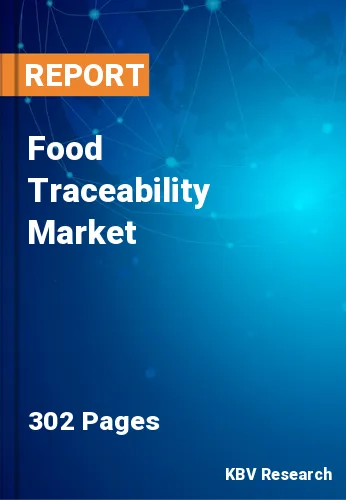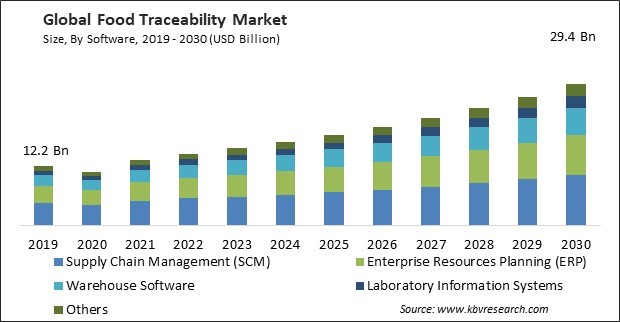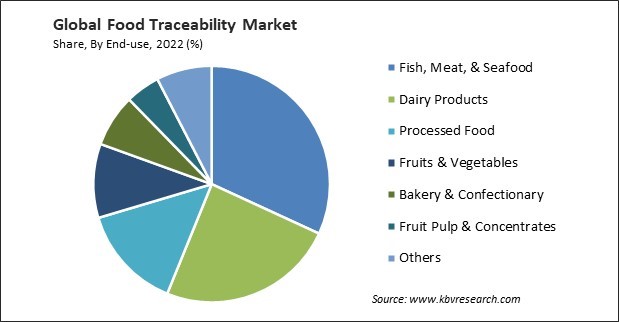
The Global Food Traceability Market size is expected to reach $29.4 billion by 2030, rising at a market growth of 9.1% CAGR during the forecast period.
Barcodes are a cost-effective solution for product identification and traceability. Therefore, the Barcodes segment acquired $5,236.0 million in 2022. Barcode technology is readily available to diverse businesses, including small and medium-sized enterprises (SMEs) whose financial resources may be limited due to its straightforward nature. The relatively low cost of implementing barcode systems makes them attractive for companies looking to enhance traceability without significant financial investment. These factors will boost the demand in the segment. Some of the factors impacting the market are increasing regulations and standards related to food safety and traceability, prevention of foodborne illnesses, and initial costs of implementing food traceability systems.

National and international food safety bodies revise and implement regulations to ensure food quality and safety. Compliance with these regulations is not only a legal requirement but is also crucial for maintaining the reputation and integrity of food businesses. The primary goal of food safety regulations is to protect public health by preventing and mitigating foodborne illnesses. Traceability solutions play a vital role in achieving this goal by enabling rapid identification and removal of unsafe products from the market. Traceability ensures a quick and targeted response to a food safety issue or contamination. Additionally, during a food safety issue or contamination, time is of the essence. Traceability systems allow food manufacturers, distributors, and retailers to quickly trace affected products' origin and distribution path. This rapid response is crucial for preventing further consumption of contaminated items and mitigating the risk of additional illnesses. Traceability systems provide granular information about each product's journey through the supply chain. This includes production date, batch number, and distribution channels. With this precise information, businesses can accurately identify and recall only the affected products, minimizing the impact on unaffected batches and reducing economic losses. Rapid and accurate traceability helps contain the impact of a food safety incident and demonstrates a commitment to quality and consumer safety, mitigating long-term damage to the brand. These aspects will drive the expansion of the market.
However, Acquiring the necessary hardware (such as barcode scanners, RFID readers, etc.) and software solutions (traceability software, database systems) can represent a substantial upfront investment. Integrating new traceability systems with existing enterprise resource planning (ERP) or inventory management systems may require additional software development or customization investments. Likewise, training employees to use the new traceability systems is crucial for effective implementation. This may involve training sessions, workshops, and educational materials. Training incurs direct costs (e.g., hiring trainers) and indirect costs (e.g., time taken away from regular work). Businesses may need to budget for technical support services to address issues and ensure the continued smooth operation of the traceability system. These aspects will restrain the growth of the market.
On the basis of software, the market is divided into enterprise resources planning (ERP), laboratory information systems, warehouse software, supply chain management (SCM), and others. The supply chain management (SCM) segment recorded the maximum revenue share in the market in 2022. Efficiency is a key consideration in the contemporary food industry, and SCM systems contribute significantly to streamlined operations. Businesses can achieve higher operational efficiency by automating and optimizing various processes within the supply chain. This includes inventory management, order fulfillment, and logistics, critical aspects of ensuring that traceability information is accurate, up-to-date, and accessible. These factors will boost the demand in the segment.
Based on end-use the market is divided into fruits & vegetables, fruit pulp & concentrates, dairy products, fish, meat, & seafood, processed food, bakery & confectionary, and others. In 2022, the processed food segment witnessed a substantial revenue share in the traceability market. Processed food manufacturers are subject to stringent quality and safety standards imposed by regulatory authorities. Traceability systems assist in maintaining compliance with these standards by enabling accurate documentation of production processes, tracking raw materials, and ensuring adherence to food safety regulations. These aspects will lead to increased demand in the future.

Based on type, the market is segmented into radio frequency identification, barcodes, infrared, biometrics, global positioning systems, and others. The biometrics segment procured a promising growth rate in the market in 2022. User authentication using biometric technologies, including fingerprint scanning, facial recognition, and palm prints, provides enhanced security and precision. In food traceability, biometrics can help ensure that only authorized personnel access and modify traceability data, enhancing the system's overall security. These aspects will lead to increased demand in the segment.
| Report Attribute | Details |
|---|---|
| Market size value in 2022 | USD 14.9 Billion |
| Market size forecast in 2030 | USD 29.4 Billion |
| Base Year | 2022 |
| Historical Period | 2019 to 2021 |
| Forecast Period | 2023 to 2030 |
| Revenue Growth Rate | CAGR of 9.1% from 2023 to 2030 |
| Number of Pages | 302 |
| Number of Table | 440 |
| Report coverage | Market Trends, Revenue Estimation and Forecast, Segmentation Analysis, Regional and Country Breakdown, Porter’s 5 Forces Analysis, Company Profiling, Companies Strategic Developments, SWOT Analysis, Winning Imperatives |
| Segments covered | Type, Software, End-use, Region |
| Country scope |
|
| Companies Included | Cognex Corporation, Honeywell International, Inc., SGS S.A., Zebra Technologies Corporation, Carlisle Technology, Bio-Rad Laboratories, Inc., C.H. Robinson Worldwide, Inc., Optel Group, Bar Code Integrators, Inc., and Food Forensics Ltd. |
| Growth Drivers |
|
| Restraints |
|
By region, the market is segmented into North America, Europe, Asia Pacific, and LAMEA. The North America segment procured the highest revenue share in the market in 2022. North American businesses have been at the forefront of adopting blockchain technology for enhanced traceability. Blockchain ensures a secure and immutable ledger, reducing the risk of fraud or errors in the supply chain. Numerous companies in the region have explored or implemented blockchain-based traceability solutions. These factors will lead to enhanced growth in the segment.
Free Valuable Insights: Global Food Traceability Market size to reach USD 29.4 Billion by 2030
The market research report covers the analysis of key stakeholders of the market. Key companies profiled in the report include Cognex Corporation, Honeywell International, Inc., SGS S.A., Zebra Technologies Corporation, Carlisle Technology, Bio-Rad Laboratories, Inc., C.H. Robinson Worldwide, Inc., Optel Group, Bar Code Integrators, Inc., and Food Forensics Ltd.
By Software
By End-use
By Type
By Geography
The Market size is projected to reach USD $29.4 billion by 2030.
Increasing regulations and standards related to food safety and traceability are driving the Market in coming years, however, Initial costs of implementing food traceability systems restraints the growth of the Market.
Cognex Corporation, Honeywell International, Inc., SGS S.A., Zebra Technologies Corporation, Carlisle Technology, Bio-Rad Laboratories, Inc., C.H. Robinson Worldwide, Inc., Optel Group, Bar Code Integrators, Inc., and Food Forensics Ltd.
The expected CAGR of this Market is 9.1% from 2023 to 2030.
The Fish, Meat, & Seafood segment is leading the Market by End-use in 2022; thereby, achieving a market value of $8.4 billion by 2030.
The North America region dominated the Market by Region in 2022, and would continue to be a dominant market till 2030; thereby, achieving a market value of $9.8 billion by 2030.
Our team of dedicated experts can provide you with attractive expansion opportunities for your business.
